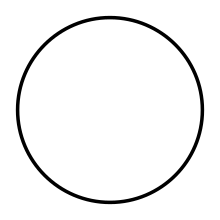User:Mark viking/Homology
Informal examples
[edit]Informally, the homology of a topological space is a set of topological invariants of represented by its homology groups
where the homology group describes the -dimensional holes in. A 0-dimensional hole is simply a gap between two components, consequently describes the path-connected components of .[1]

A one-dimensional sphere is a circle. It has a single connected component and a one-dimensional hole, but no higher dimensional holes. The corresponding homology groups are given as
where is the group of integers and is the trivial group. The group represents a kind of one-dimensional vector space, with integer coefficients, that represents the single one-dimensional hole contained in a circle. [2]

A two-dimensional sphere has a single connected component, no one-dimensional holes, a two-dimensional hole, and no higher dimensional holes. The corresponding homology groups are[2]
In general for an -dimensional sphere , the homology groups are

A one-dimensional ball is a solid disc. It has a single connected component, but in contrast to the circle, has no one-dimensional or higher-dimensional holes. The corresponding homology groups are all trivial except for . In general, for an -dimensional ball ,[2]

The torus is defined as a Cartesian product of two circles . The torus has a single connected component, two independent one-dimensional holes (indicated by circles in red and blue) and one two-dimensional hole as the interior of the torus. The corresponding homology groups are[3]
The two independent 1D holes form a two-dimensional vector space with integer coefficients, producing the Cartesian product group .
References
[edit]- ^ Spanier, Edwin H. (1966). Algebraic Topology. Springer. p. 155. ISBN 0-387-90646-0.
- ^ a b c Timothy Gowers, June Barrow-Green, Imre Leader (2010). The Princeton Companion to Mathematics. Princeton University Press. pp. 390–391. ISBN 9781400830398.
{{cite book}}: CS1 maint: multiple names: authors list (link) - ^ Hatcher, Allen (2002). Algebraic Topology. Cambridge University Press. p. 106. ISBN 9780521795401.























